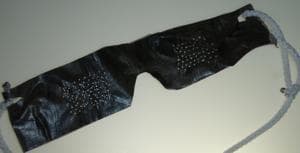Emergency Glasses
Without glasses, my entire mid to long-distance view is fuzzier than green bologna in the back of the 'frig. If I were to lose or damage my glasses on a kayaking trip, I would be dead in the water as far as being able to do many activities. I am therefore diligent in bringing an extra pair - even if the prescription is a bit old - on a trip, just in case!
But what can you do should you lose or destroy the only spectacles you have? A classic Twilight Zone episode features a lone survivor of a nuclear attack. He is an avid reader who finds years worth of books undamaged in the city library. Soon after stockpiling a decade's supply of volumes he accidentally drops and breaks his thick reading glasses. Should you ever find yourself in a similar predicament (broken glasses, that is) don't worry; if you have duct tape, some wire or a big needle (or a sharp hawthorn or locust thorn handy) you can create a usable pair of glasses.
These glasses will be similar to Eskimo "snow goggles" made of slats of bone or other materials. The wearer would look through a narrow, horizontal slit in the eye slat. This minimized the amount of sunlight and reflective glare entering the eye from the white snowy surface below.

These emergency glasses are designed to restore a bit of your sight by working on the principle of the pinhole camera. The pinhole captures only certain straight rays of light that focus on the retina of the eye (or on the film plane of a pinhole camera). Align several of these pin holes onto an opaque surface and look through it, and voila! - each hole becomes a tiny lens offering a clearer image.
The first step is to take a 12" - 14" piece of 2" duct tape, fold it in half lengthwise and press the adhesive backs together.
Step two starts by finding the center of the strip and cutting out a nose notch, then measure equally out from the notch to the center of each eye. Mark each center for the field of holes you'll be punching through the tape.

Next, get a piece of wire the size of a large paper clip. In an emergency consider a large thorn from a locust or hawthorn tree. The more perfectly round each hole is, and the cleaner the edges, the better it acts like the lens on a pinhole camera.
You want to make a field of holes at least as wide and high as your eye is round. My pair has eight rows with about 10 holes in each row. The rows are about 1/8" across and the holes are about 1/8" apart. I staggered each row of hole just like the stars on the American flag are staggered. I used the heated tip of a large needle to make the holes quickly and cleanly.

There are many materials out of which this eye strip can be made. As long as you can create rows of uniform, clean-edged holes, you can use anything stiff enough, yet pliable to be worn as a mask over the eyes. Doubling a strip of duct tape back on itself gives you a perfect thickness to create these glasses.

You then tie on a piece of string or shoelace to each outside corner of the "glasses" and then tie the mask in place across your eyes. Finally, adjust the ban so each eye can look directly out through the field of small holes. Once in place you should see things clearly although you might have little halos around images and other visual "ghosts" but they are clear enough that you can read what would otherwise be quite blurry.
Getting back to the snow blindness goggles, the duct tape technique can also be used to make a similar pair of lenses to be worn against glare off the water. It's not the fanciest piece of eye wear, but it is crudely functional. Besides, when you've got nothing else, these "glasses" can save your day.
Tom Watson, an avid sea kayaker and freelance writer is also the author of "How to Think Like A Survivor" available on Amazon.com and most major bookstores.
Related Articles
This a follow up to a video I did where I talked about differences that you may find in dry and semi-dry…
Can you use a Greenland Paddle in a Recreational Kayak? I received this question recently from a…
Learn how to stay comfortable on the water when fishing in the cold. When you stay warm and…
Mention guns and canoe trips in the same breath and some folks are apt to go ballistic. Still, if you're…



